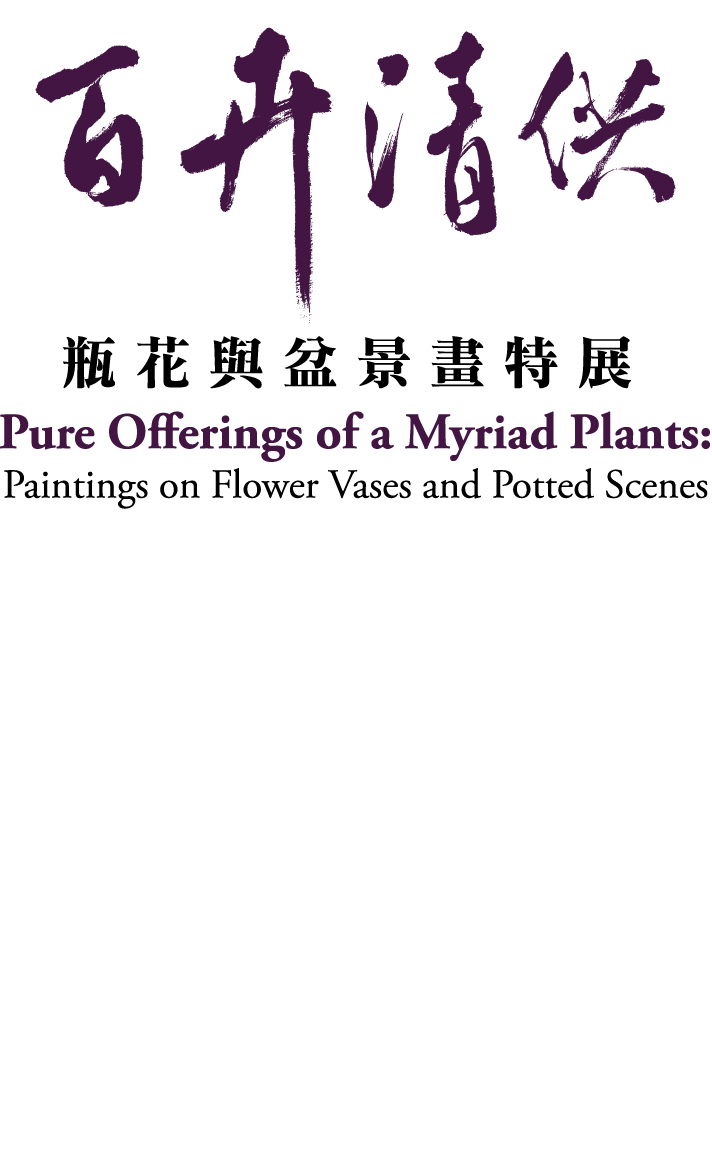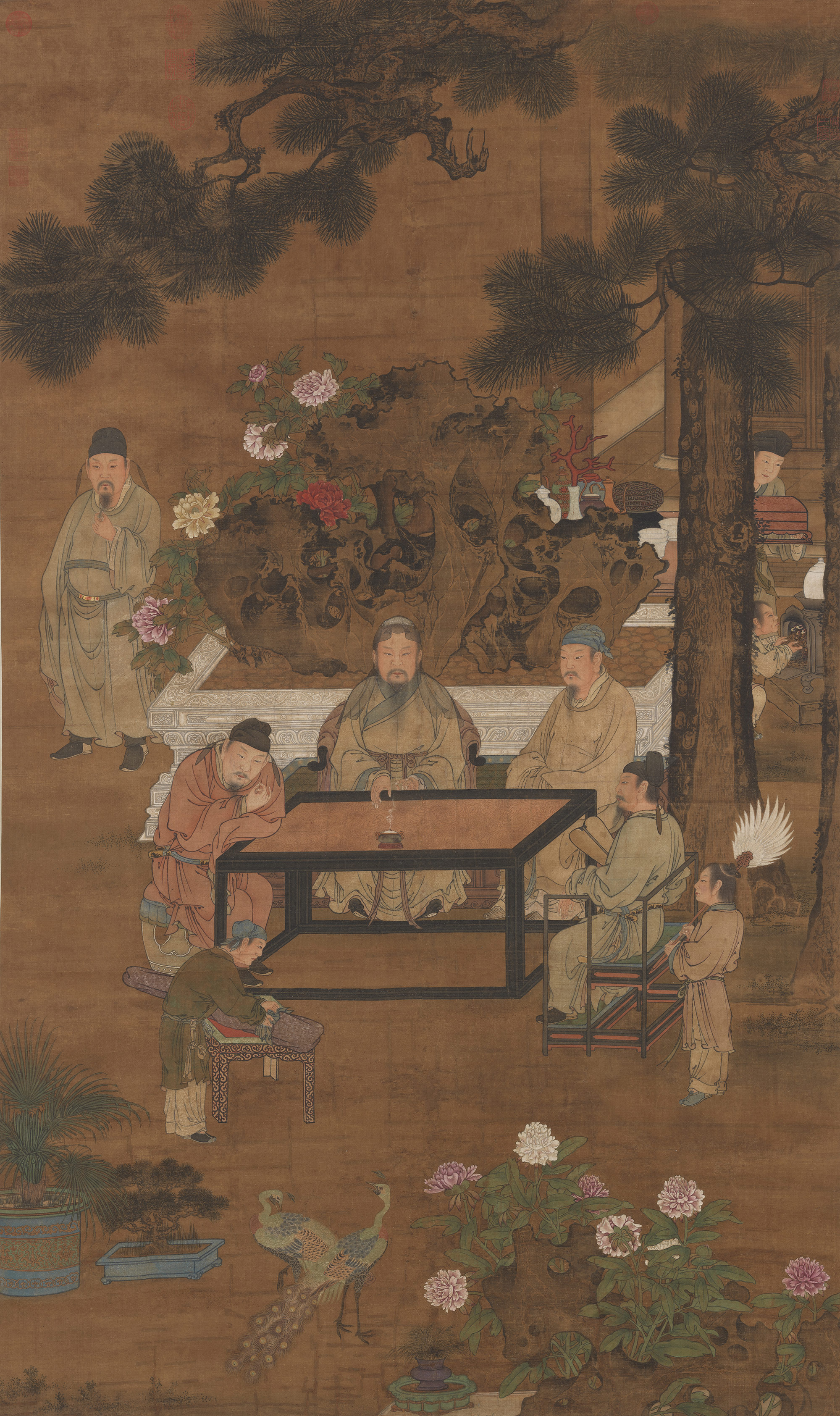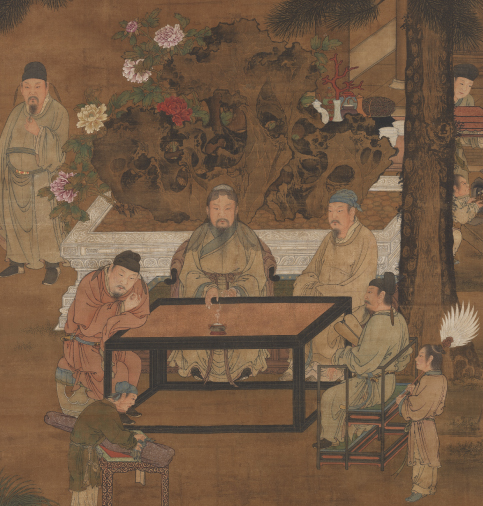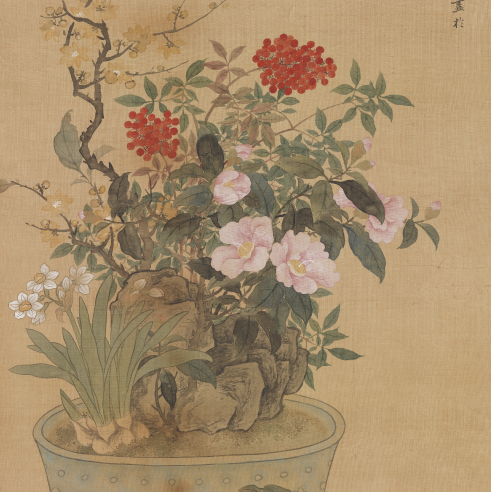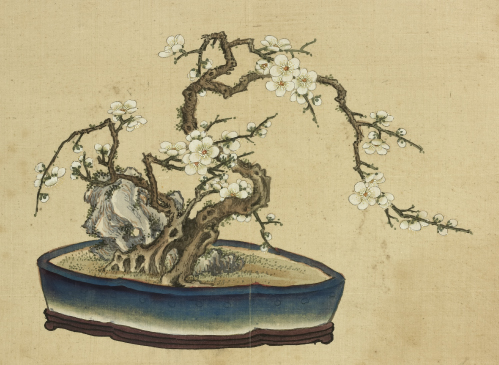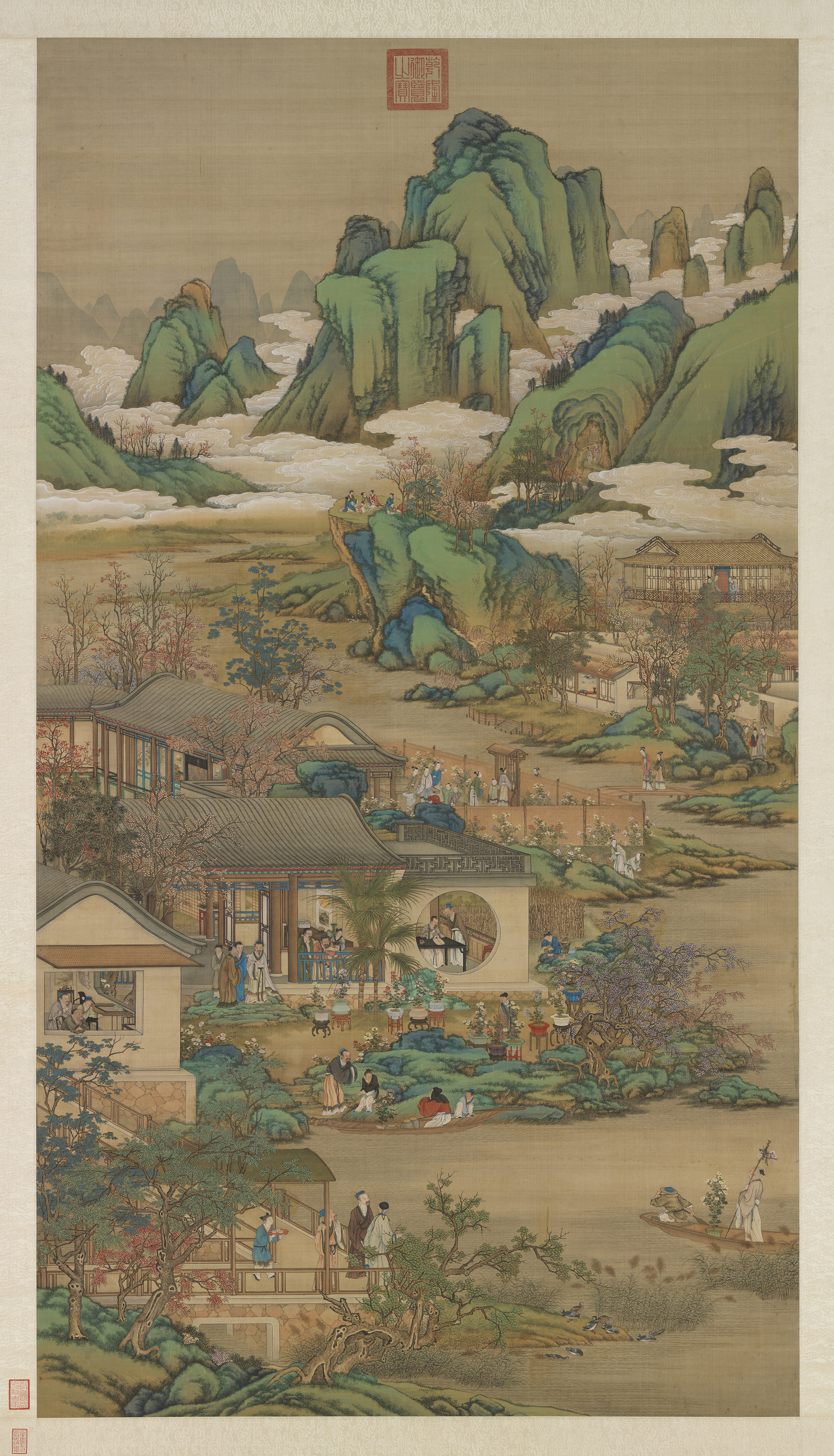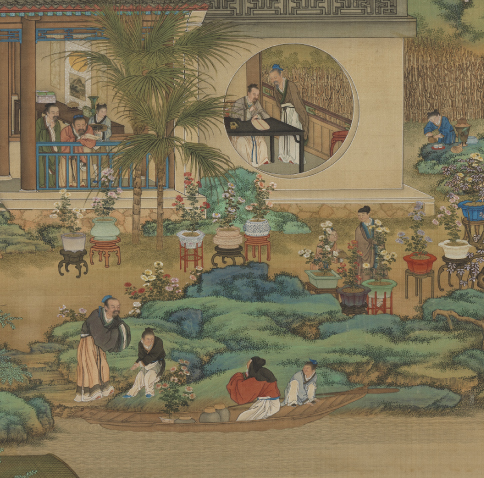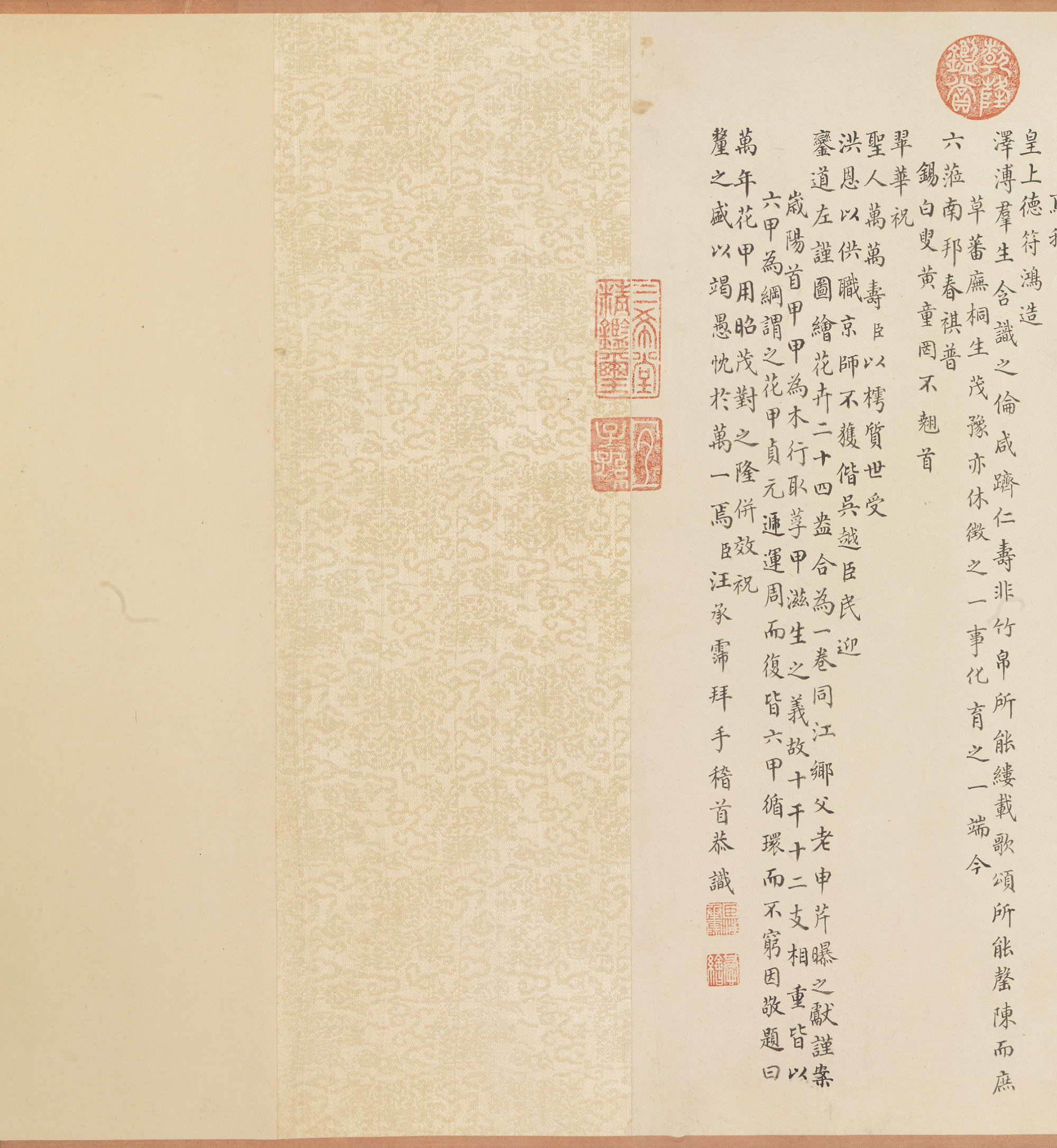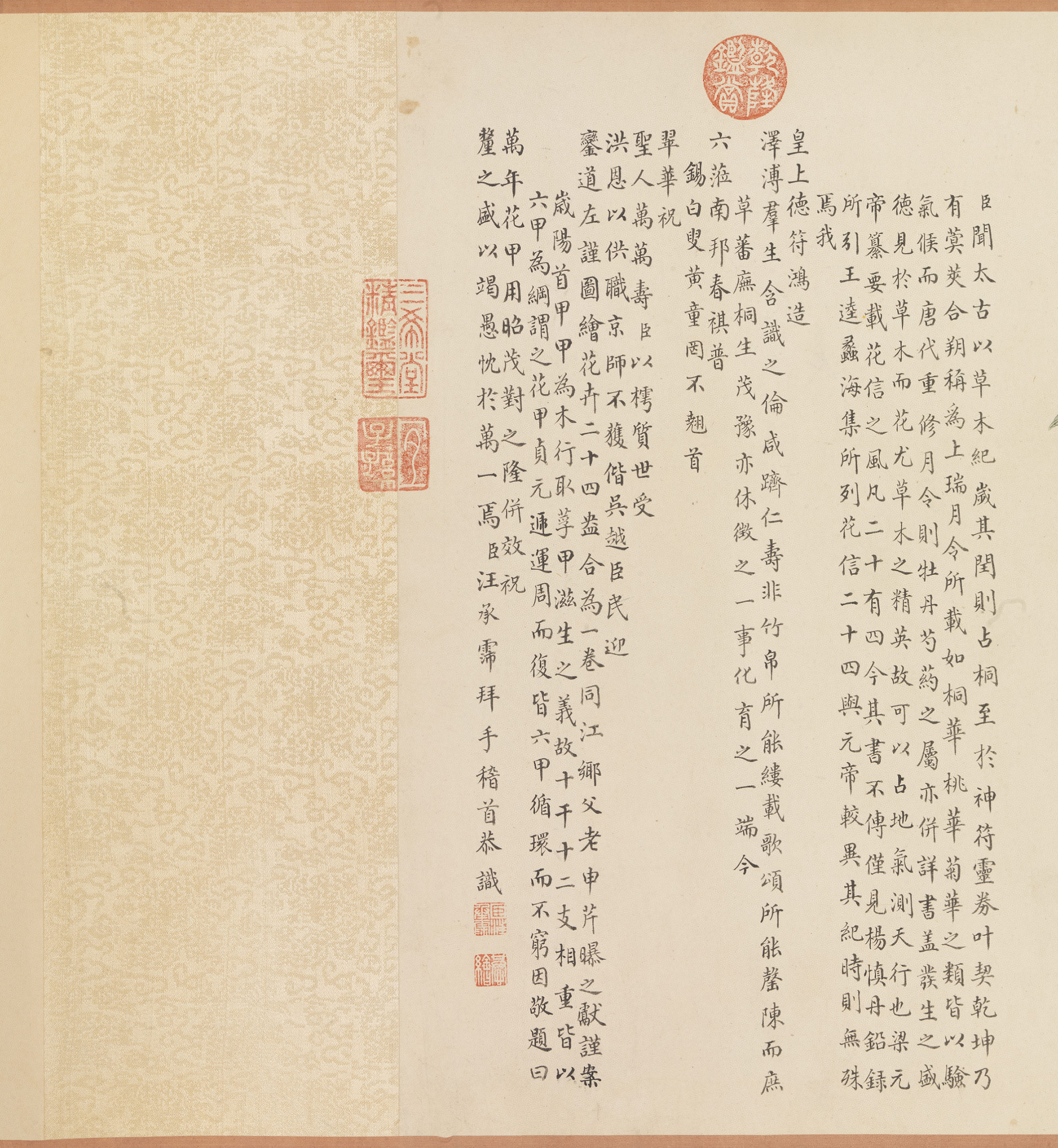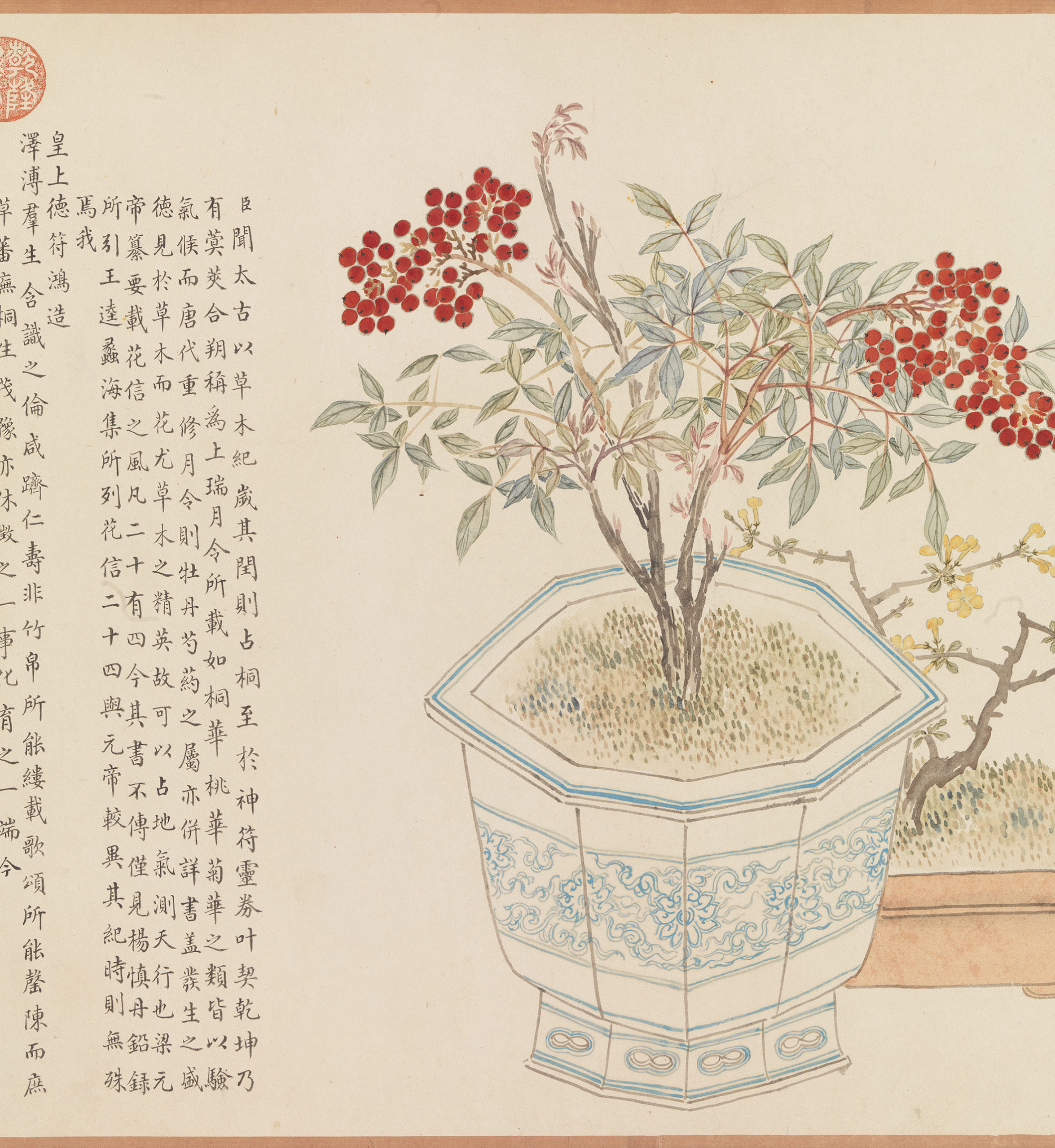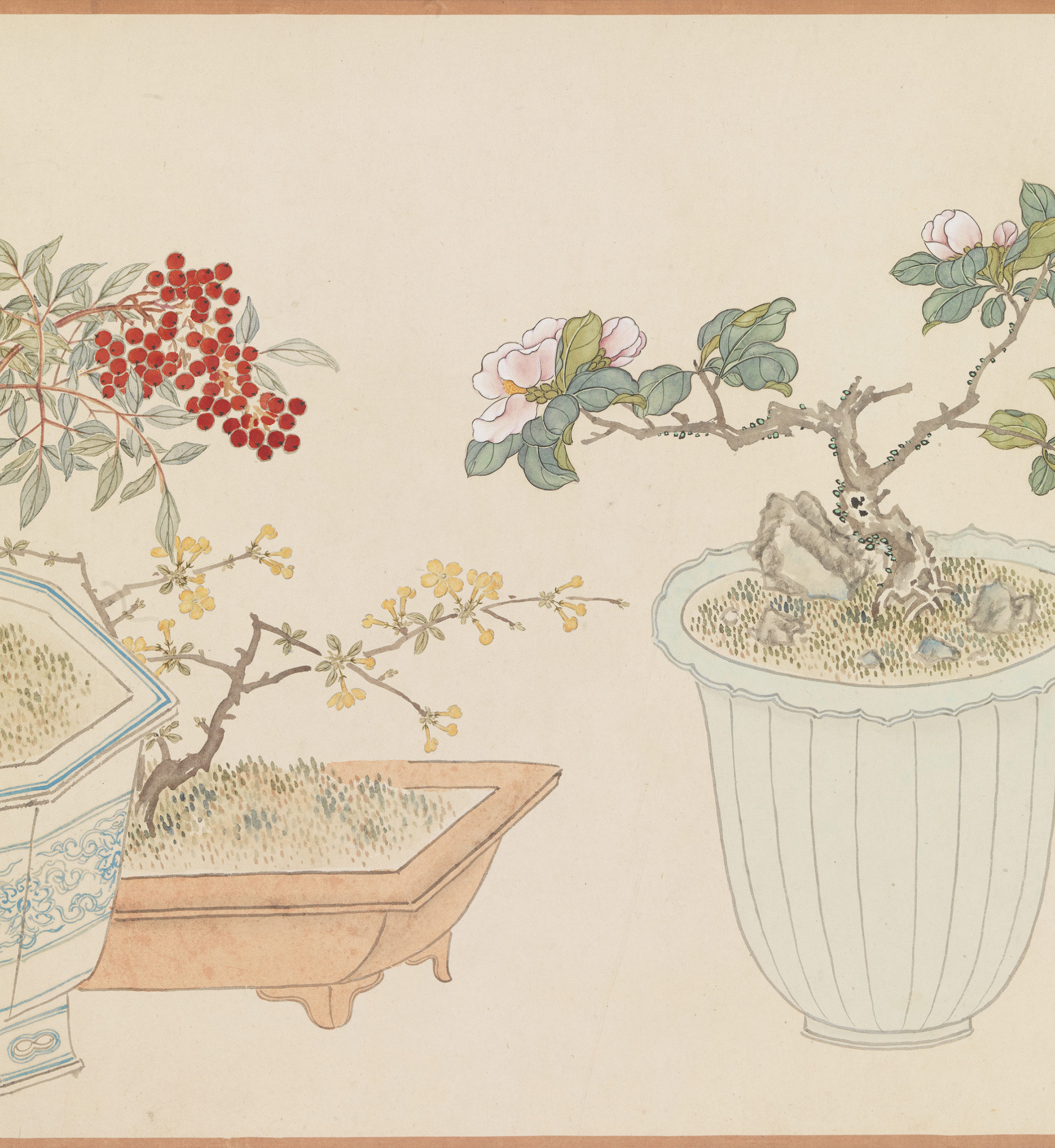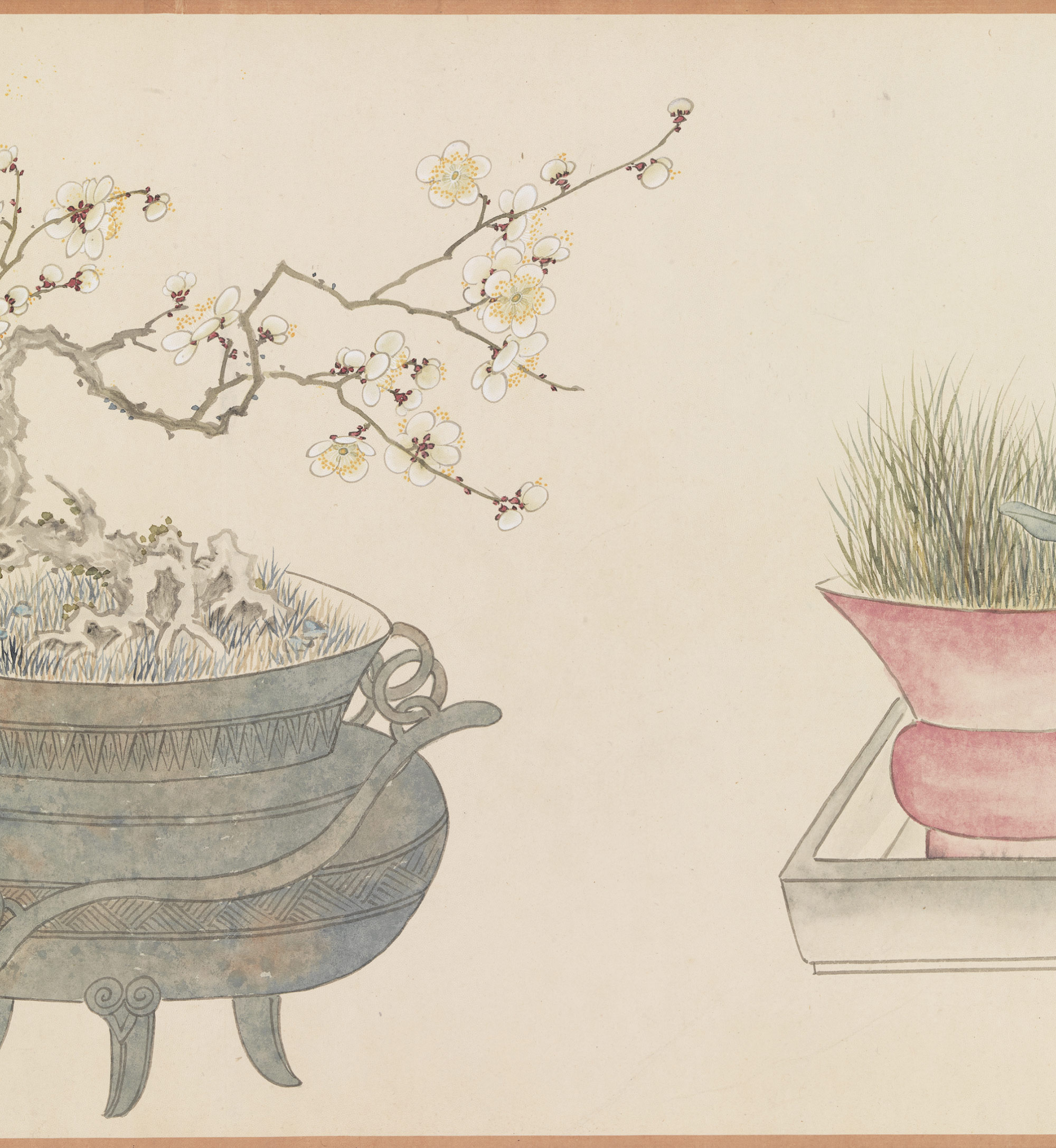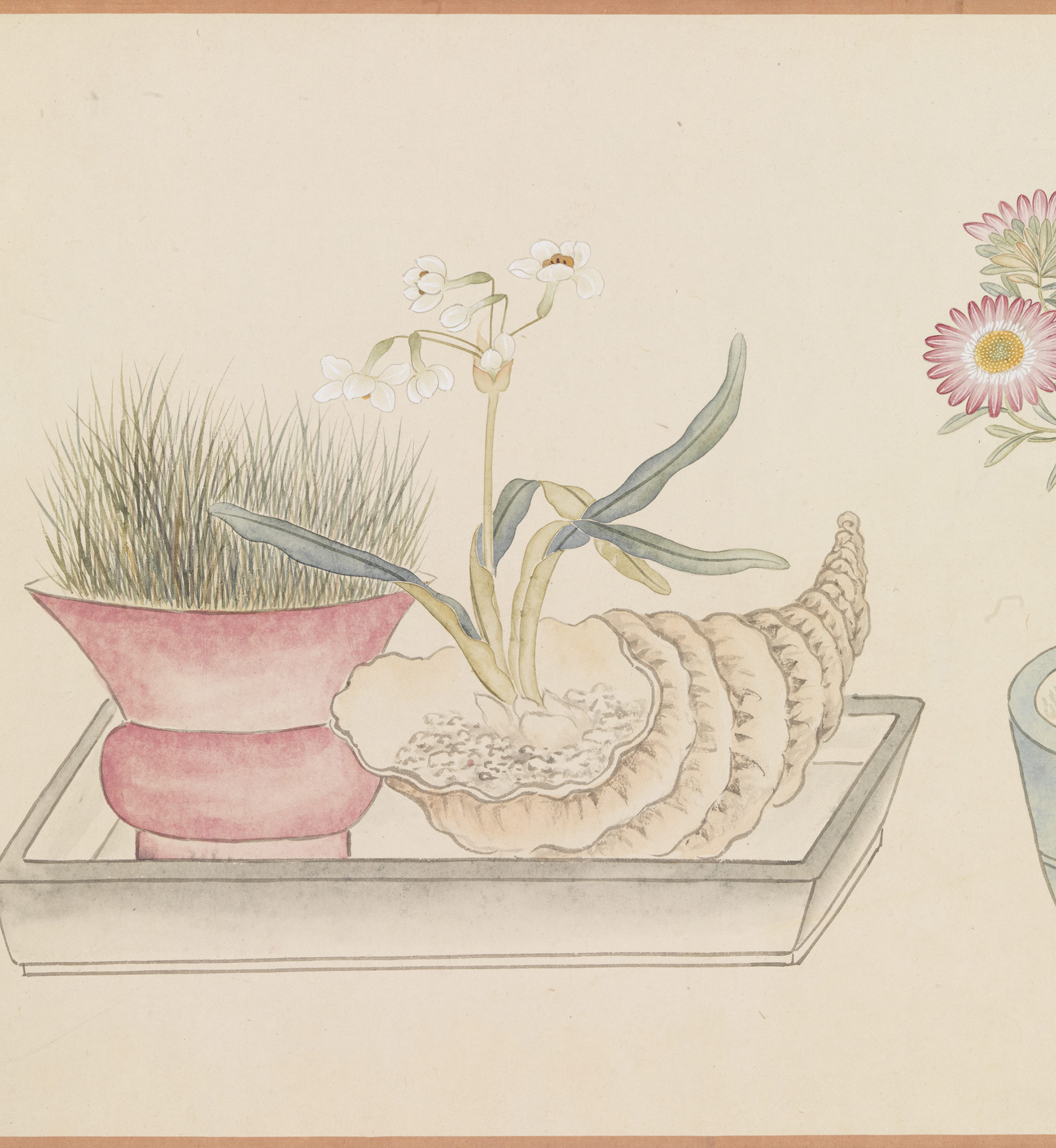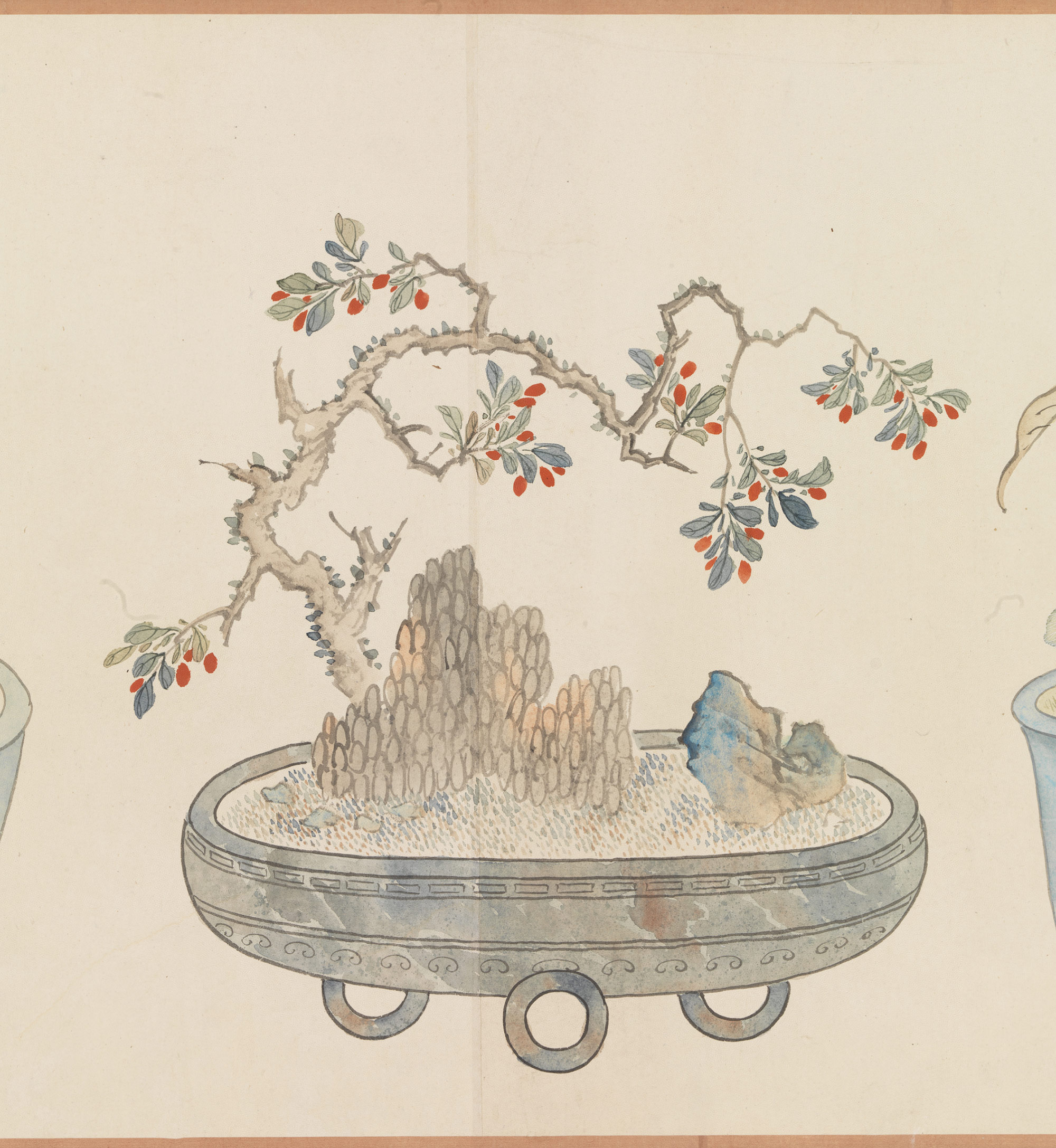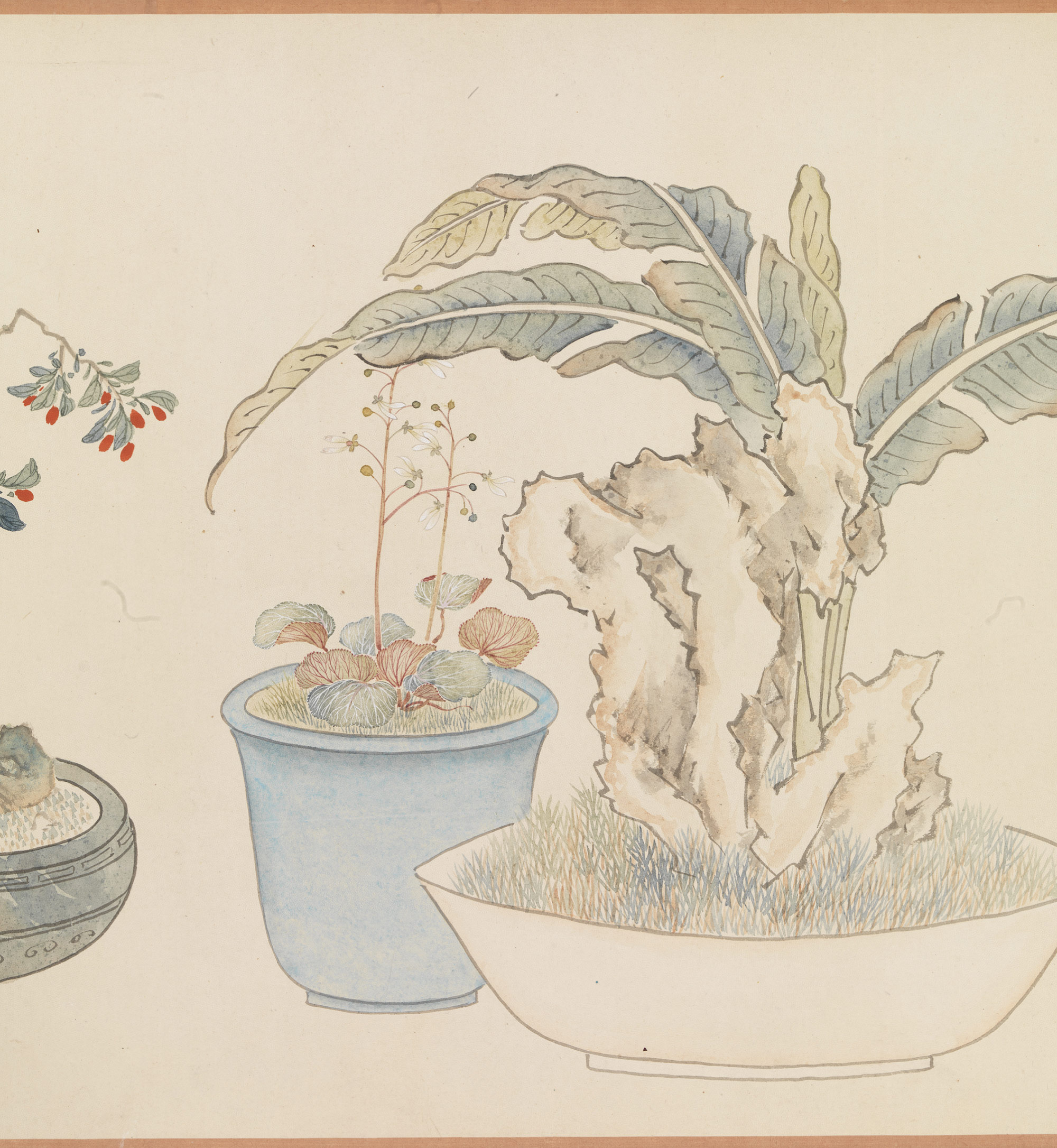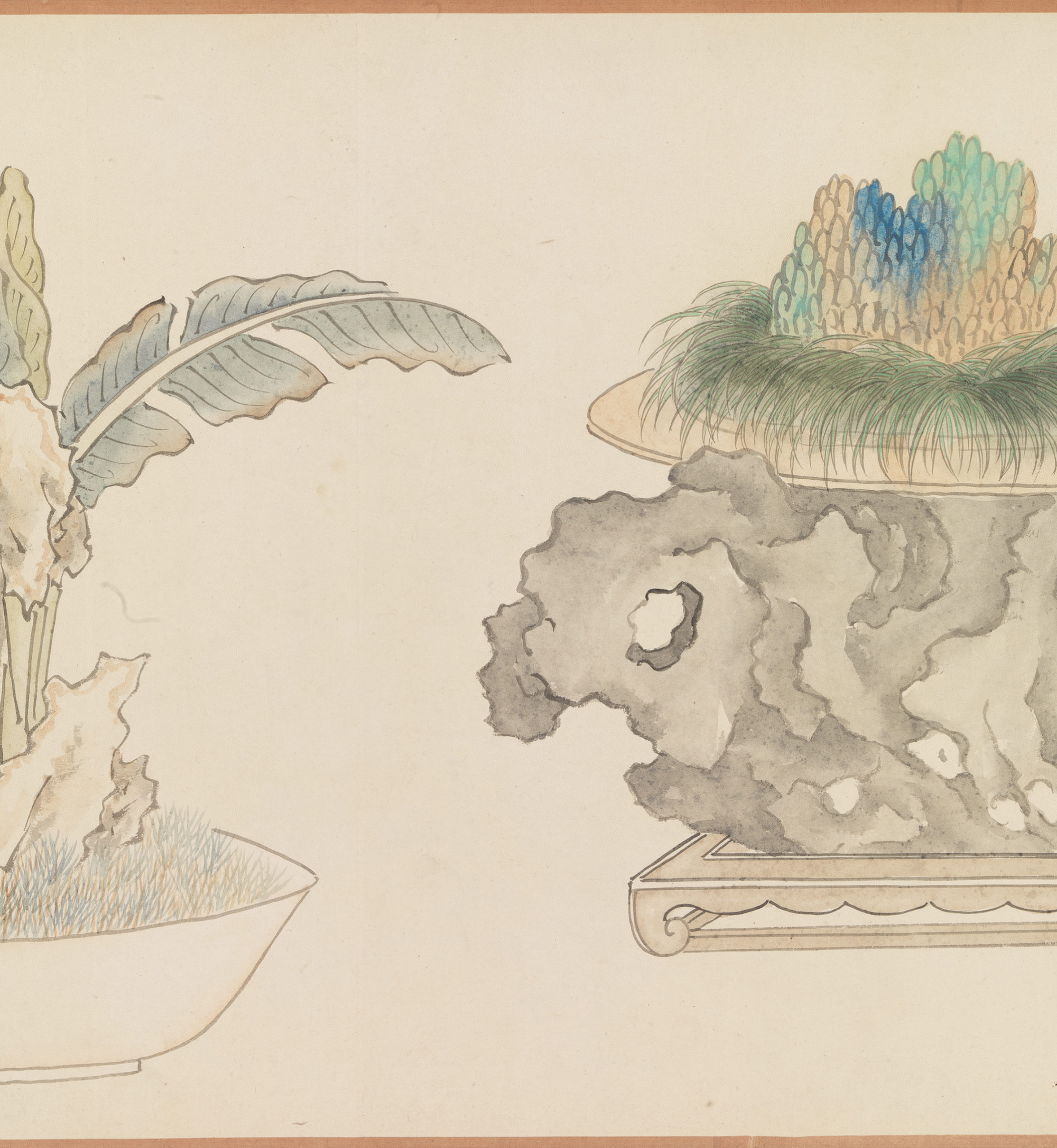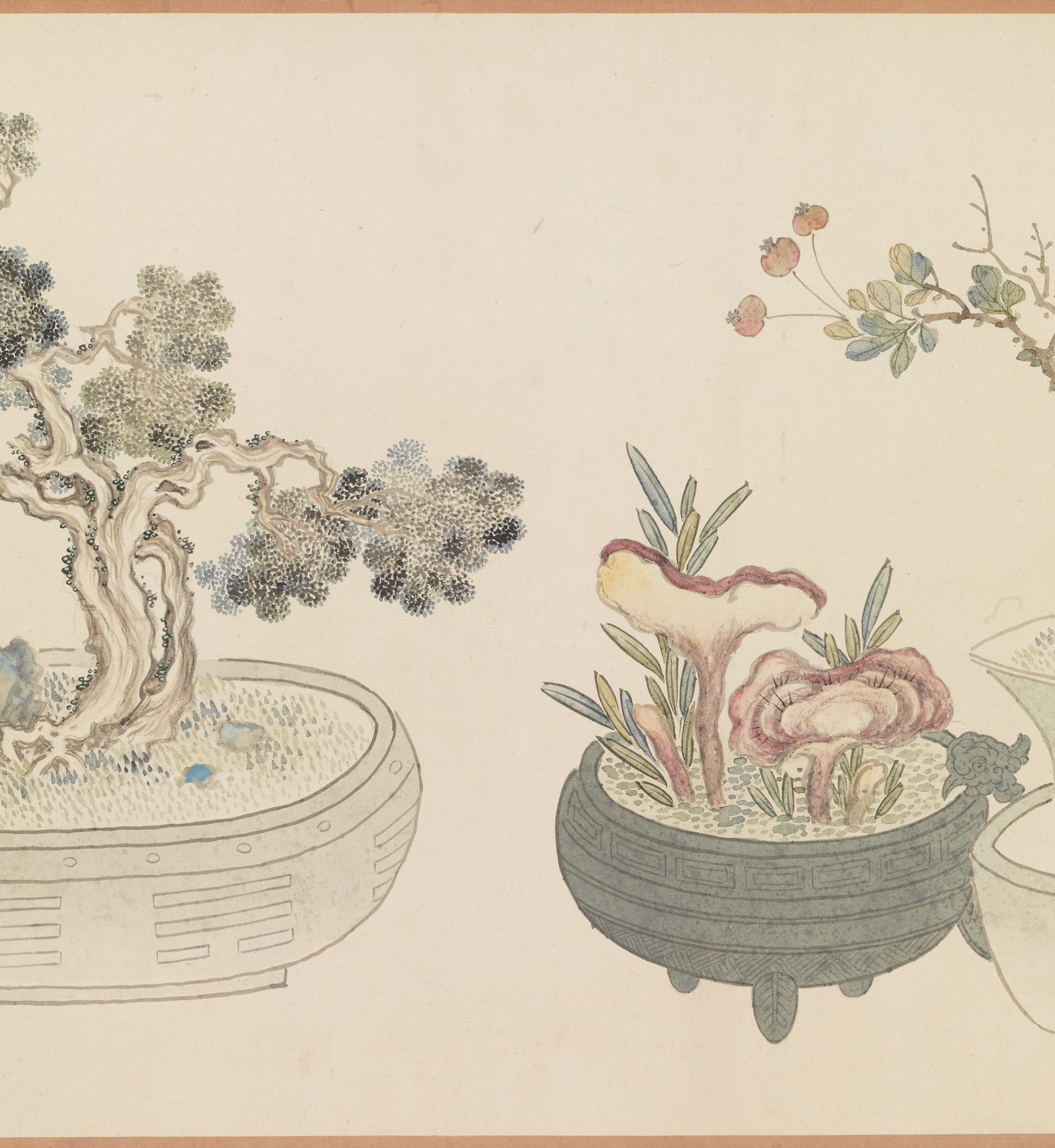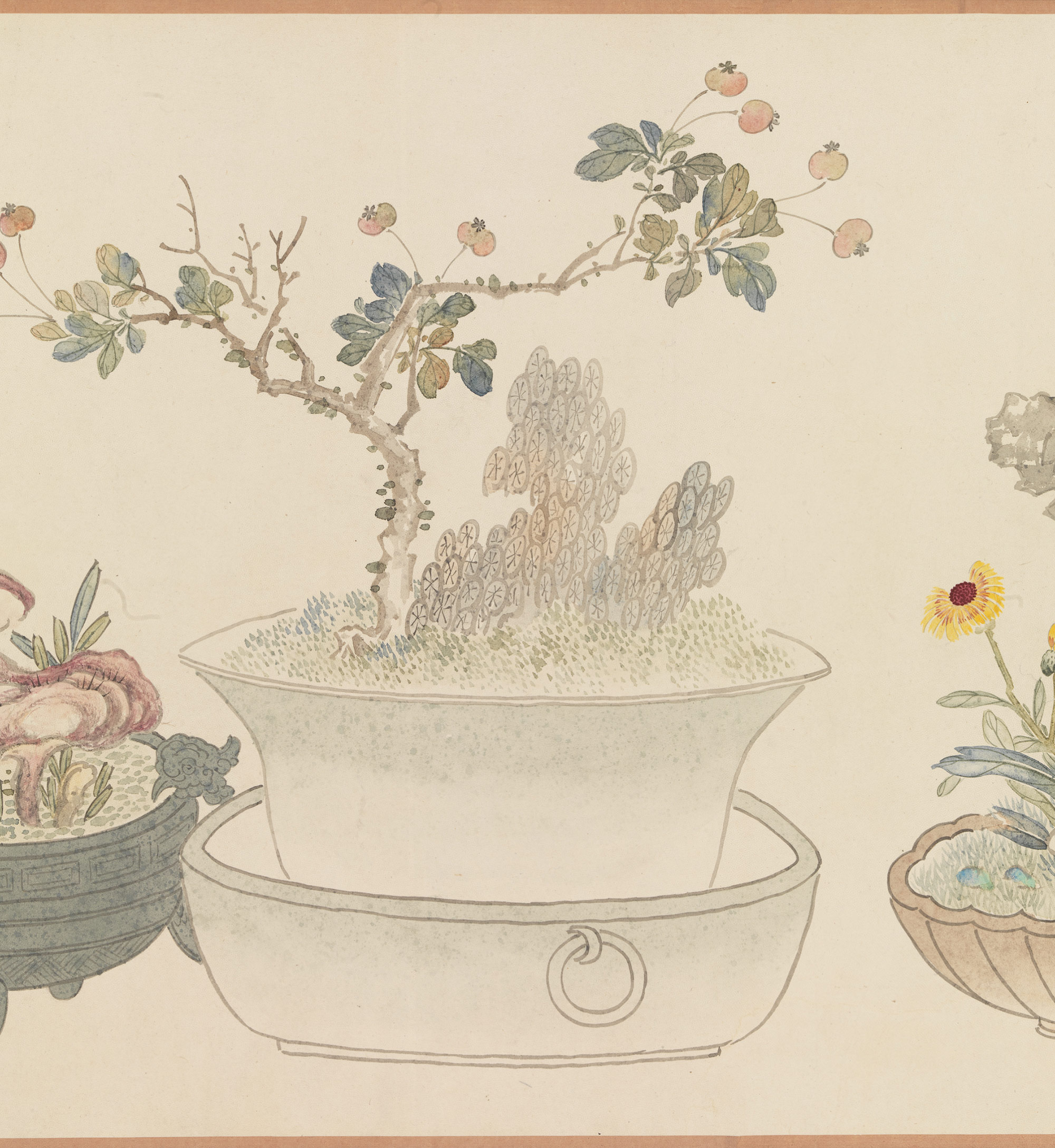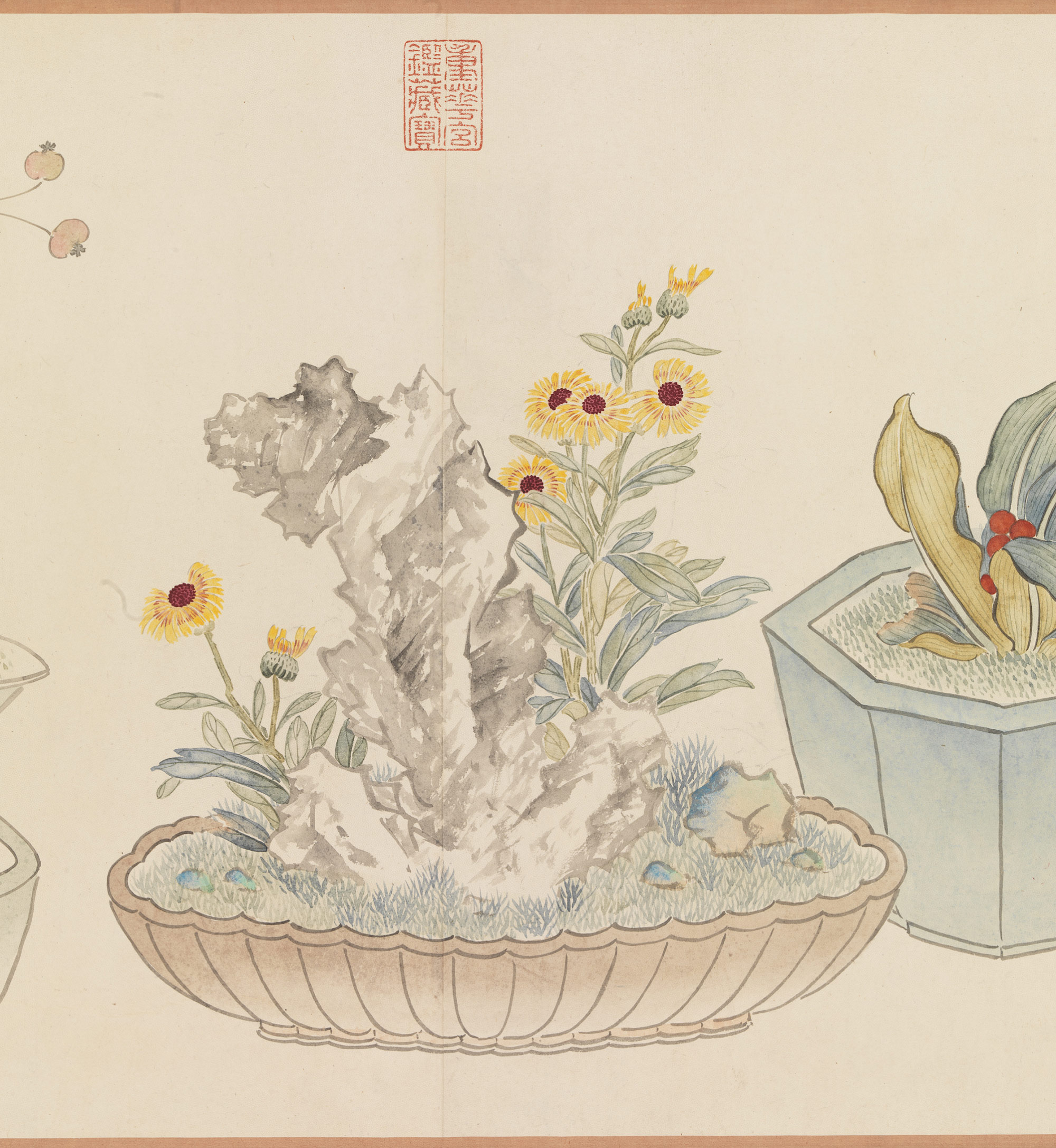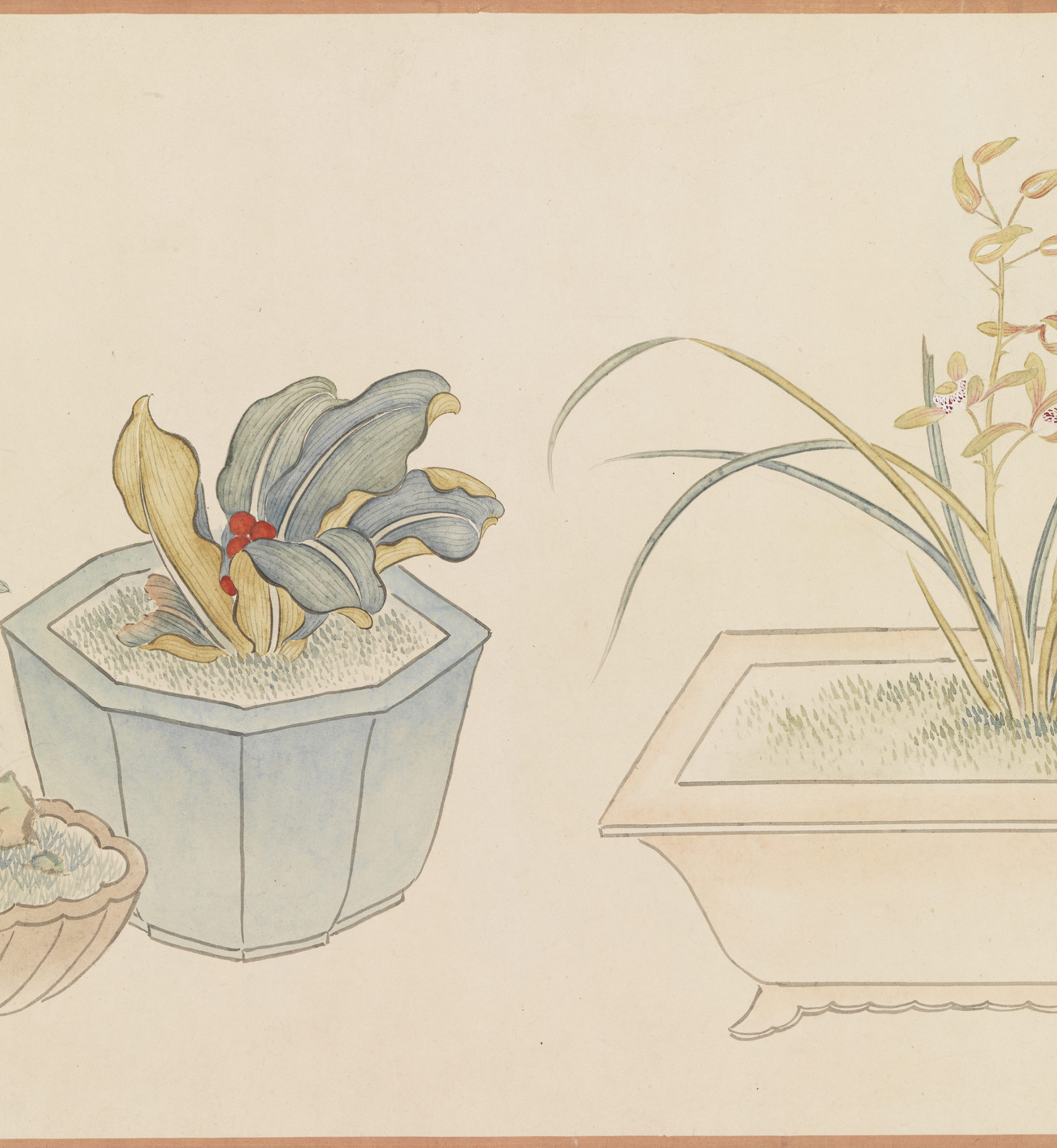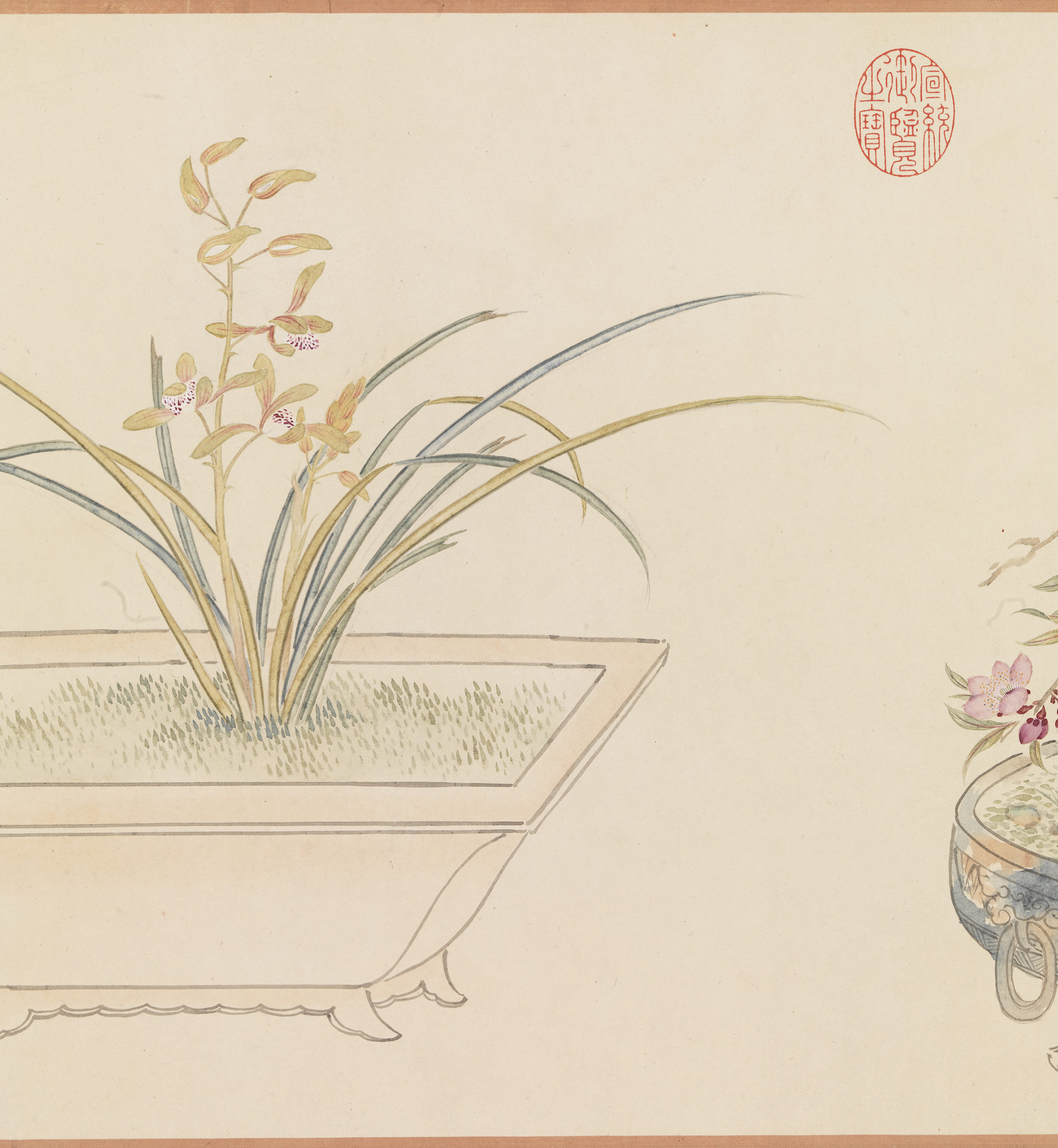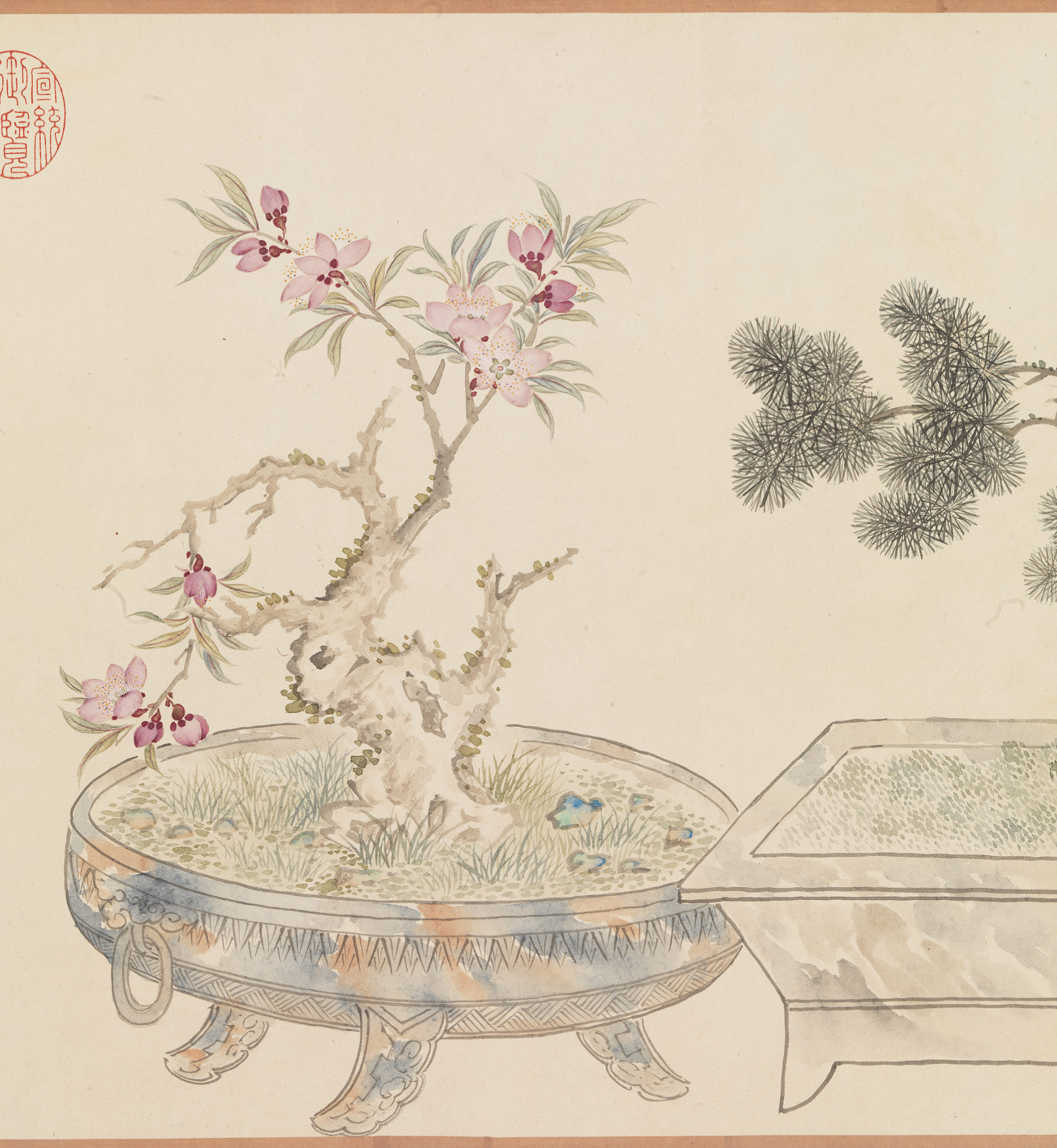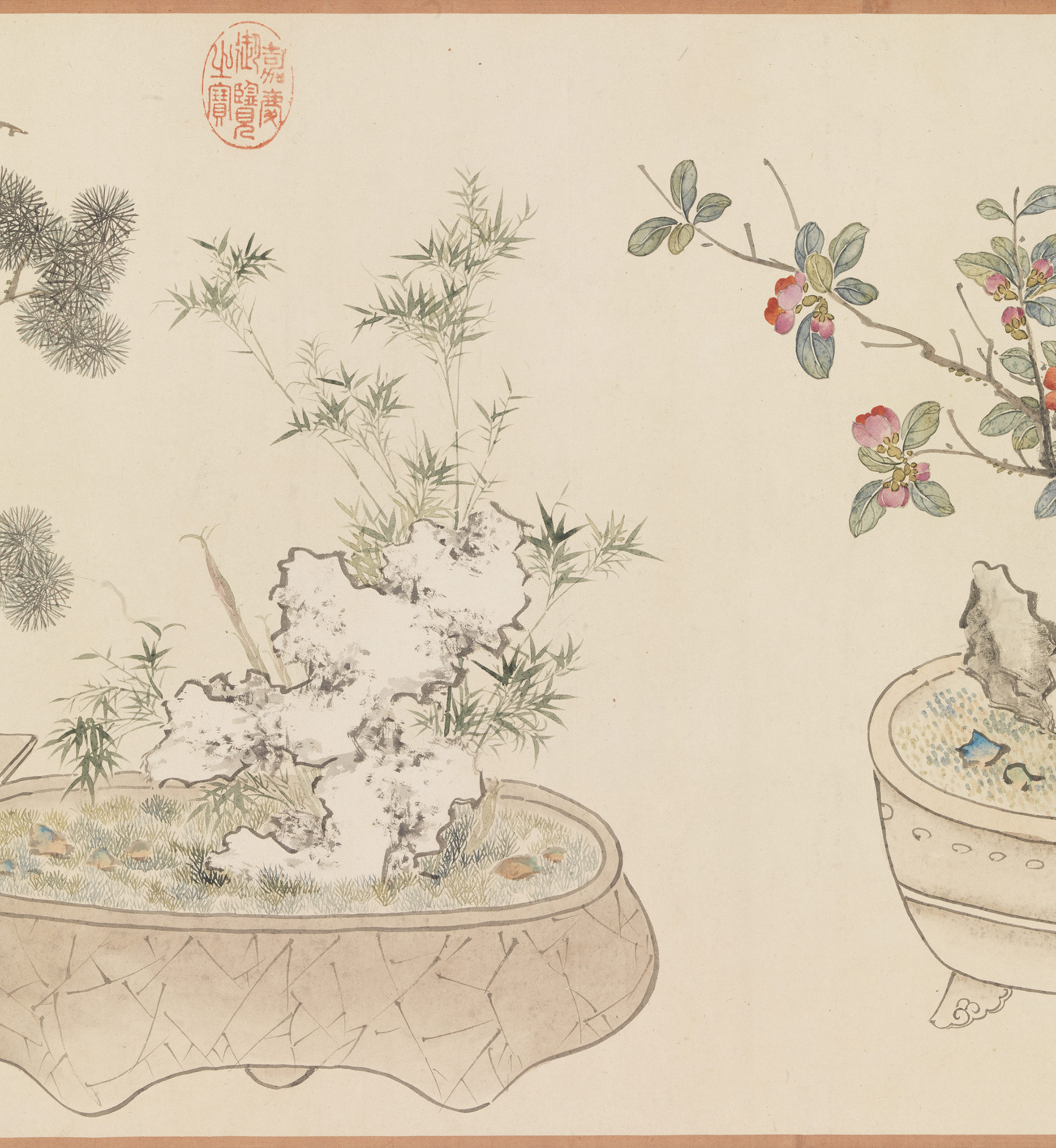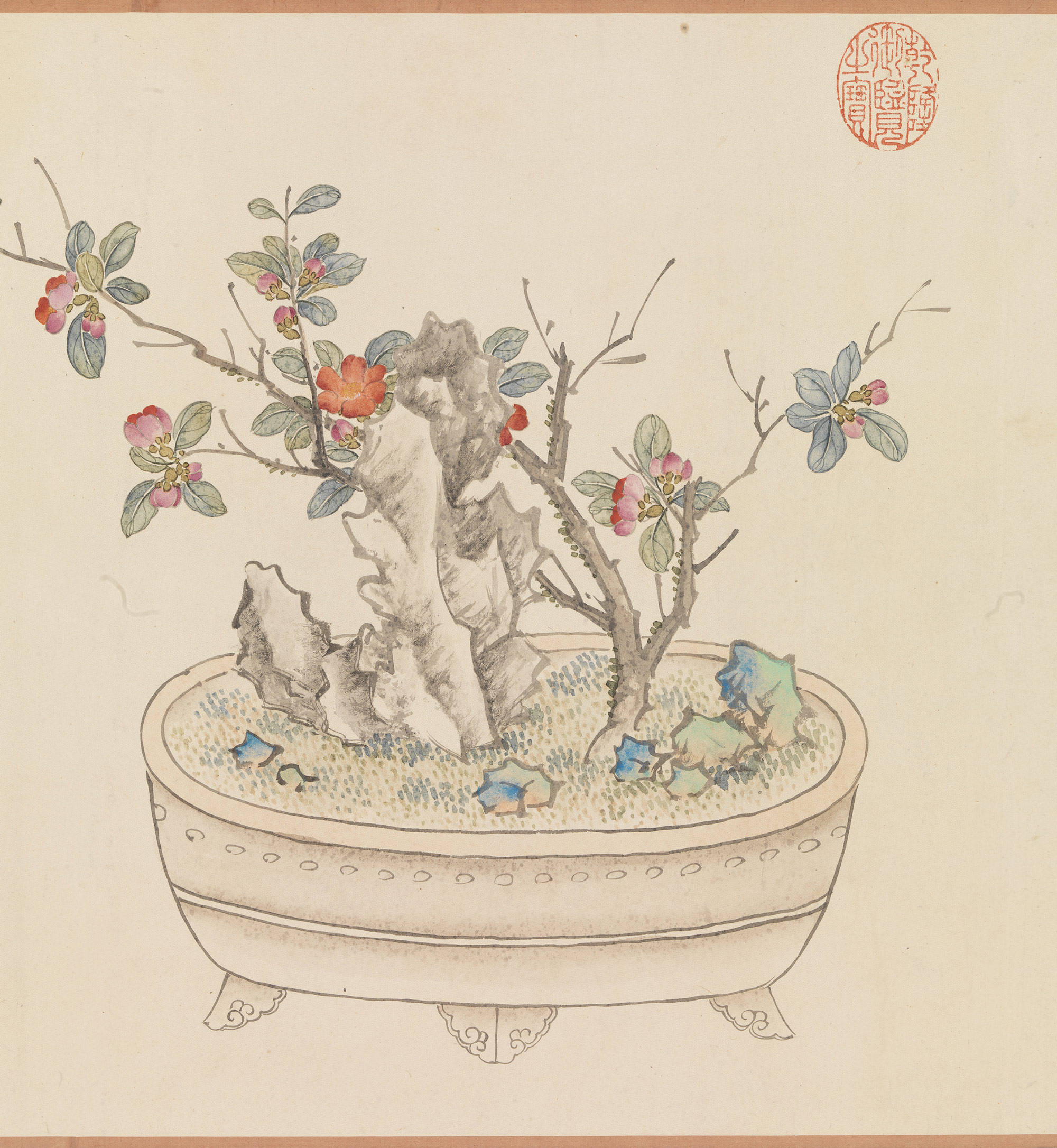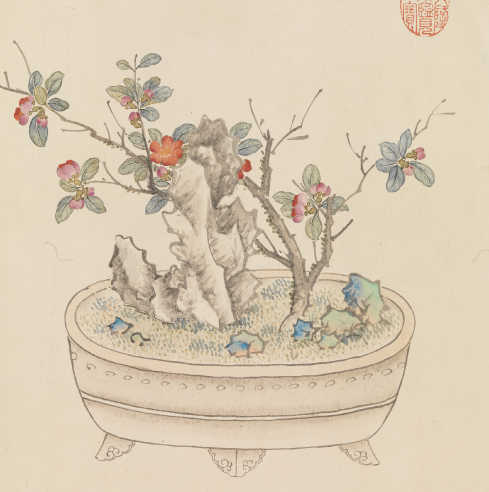Scenes in Planters
-
Potted scenes take rocks and vegetation as their raw materials, the latter trimmed, manipulated, and grown in planters to convey the beauty of nature in miniature via horticulture. It was popular in palaces during the Tang dynasty and Five Dynasties period to grow trees in and landscape courtyards, leading to further interest in plant and flower types as well as techniques cultivating them. The focus on life and leisure at the court and among literati in the Song dynasty led to greater appreciation of seasonal flowers and rock cultivation as well as the arranging of flower beds and garden rocks. Planters were placed in gardens and hallways both for appreciation and decoration.
-

-
In the Ming and Qing dynasties, the production and appreciation of potted scenery reached unprecedented heights with all sorts of vegetation included (trees, flowers, foliage plants, grasses), the types of containers for them equally varied. Potted scenes are generally divided according to subject matter and form of expression, the two major categories being potted landscapes and flower-and-tree potted scenes. Special attention is evident in planning and arrangement to fully express the lofty aesthetic of literati. And painters throughout the ages rendered the marvels of these potted scenes via their brushwork to portray nature in miniature, imbuing the beauty of flowers and trees with deeper meaning while raising their value for aesthetic appreciation.
-
The Eighteen Scholars (Zither)
- Attributed to an anonymous artist, Song dynasty (960-1279)
- Hanging scroll, ink and colors on silk, 173.5 x 102.9 cm
Old pines stand tall in a courtyard as a large lake rocks sits in a marble planter within this garden setting planted with peonies of different colors. A scholar sits upright as he prepares to play the zither, a burner on the table for incense. Young attendants mill about in various activities, such as unwrapping the zither, holding a feather fan, or bringing a tea box. The potted scenes in this painting are numerous, including those with peony, pine, palm, and calamus. The pine has been pruned in a painterly manner, while the palm and calamus retain much of their natural beauty. The bluish-glaze flower planters and saucers are arranged meticulously in rectangular, round, "zhadou"-vessel, and petal shapes.
Literati emphasized the aesthetics of life in tree-garden settings, planters also used to beautify residential spaces. Judging from the antiquities in this painting, they all belong to the style of the Ming dynasty (1368-1644). The objects in this painting are displayed with refinement, demonstrating the aesthetics of life enjoyed among the elite in Ming society.
-
Beautiful Scene for the New Year
- Chen Shu (1660-1736), Qing dynasty
- Hanging scroll, ink and colors on silk, 96.8 x 47 cm
Chen Shu (style name Nanlou, sobriquet Shangyuan dizi, late sobriquet Nanlou laoren), a native of Xiushui (Jiaxing) in Zhejiang, was a famous woman painter in the Yongzheng reign (1722-1735). She was equally proficient at landscape and bird-and-flower subjects as well as fine-line and sketchy styles, all without losing a quality of pure elegance.
In this painting are chimonanthus, camellia, nandina, and narcissus blossoms. Cut and arranged as a whole, they are planted in proportion and height to the celadon planter. Not only does this extend the period of their appreciation, it also reduces the amount of maintenance work, representing a perfect combination of flower arrangement and potted scenery. To the side are a lily bulb, persimmons, apple, spirit fungus, and olives that symbolize the idea of a "hundred things as you please." This painting from life of a floral offering for the New Year is rich in the joyous atmosphere of welcoming the year. Dated to 1735, it is a late work by Chen Shu.
-
Plum Tree Planter
- Wang Tubing (1668-1743), Qing dynasty
- Album leaf, ink and colors on paper, 20.2 x 28.6 cm
This potted scene includes a rock; the contorted branches of the miniature plum tree extend diagonally with craggy exposed roots that rest upon and cling to the rock, evidence of many years of binding and manipulation to create this effect. These white plum blossoms of early spring feature petals clustered sparingly for a sense of space. The flowers are done with fine brushwork and heavy colors, the hues pure yet lofty and the garden rock rendered with washes of ink in different shades.
The planter in the shape of a begonia blossom has a flat bottom and rests on a wooden stand, the walls of this ceramic vessel covered with a fusion of blue and purple glaze. Fired with a rim emulating a drum-stud pattern, the form is beautiful and the colors appealing. This leaf is the sixth from Wang Tubing's "Album of Poetry and Painting on Winter Scenes and Flowers." The fifth leaf is Wang's transcription in semi-regular script of "Two Regulated Verses on a Potted Plum Tree" by the Qianlong emperor; the poetry, however, is apparently not recorded.
-
Activities of the Twelve Lunar Months: The Ninth Month
- Court artists, Qing dynasty (1644-1911)
- Hanging scroll, ink and colors on silk, 175 x 97 cm
Gardens and buildings appear here and there in a blue-and-green landscape on the scale of a imperial garden design, the trees and plants equally abundant. Ascending the heights to view the distance, appreciating chrysanthemums, and drinking wine were all customs of the Double Ninth Festival. With chrysanthemums elegantly rustic, the colorful plants of autumn indicate the change of the seasons for scenery pleasing to the eye. Chrysanthemums in full bloom grown on the ground by the fence appear with ladies and children playing among them. In the middleground, people gather to admire chrysanthemums vying for beauty in a courtyard. Complemented by various porcelain planters and stands, their beauty abounds. A small boat in the foreground delivers a potted plant and wine jugs, the visitor on board getting ready to alight on the bank.
Depicting activities related to the twelve lunar months was a kind of traditional genre painting. This work is unsigned but represents part of a cooperative effort by court painters during the Qianlong reign (1736-1795).
-
Floral Cycle of Longevity
- Wang Chengpei (?-1805), Qing dynasty
- Handscroll, ink and colors on paper, 37.5 x 549.8 cm
Wang Chengpei (style name Chunnong, sobriquet Shizhai), a native of Qiantang in Zhejiang, was a Provincial Graduate of 1747 and served to the post of Left Vice Minister of Works and Minister of War. In 1805, he applied to retire and returned home only to die along the way. He excelled at poetry and was gifted at calligraphy and painting."
In 1784, the Qianlong emperor on his sixth southern inspection tour ordered Wang Chengpei to do this painting. The handscroll includes a total of 24 different types of potted floral scenes luxuriously presented in porcelain and bronze containers, the colors fine and beautifully upright. The artist skillfully and creatively arranged the flowers and miniature trees in different containers to represent the common and the refined. Flowers of the four seasons are all shown together in bloom or fruit as a symbol of clarity in government manifested in the plant world, having the meaning of a "hundred flowers exhibiting auspiciousness, a world in peace and prosperity.
